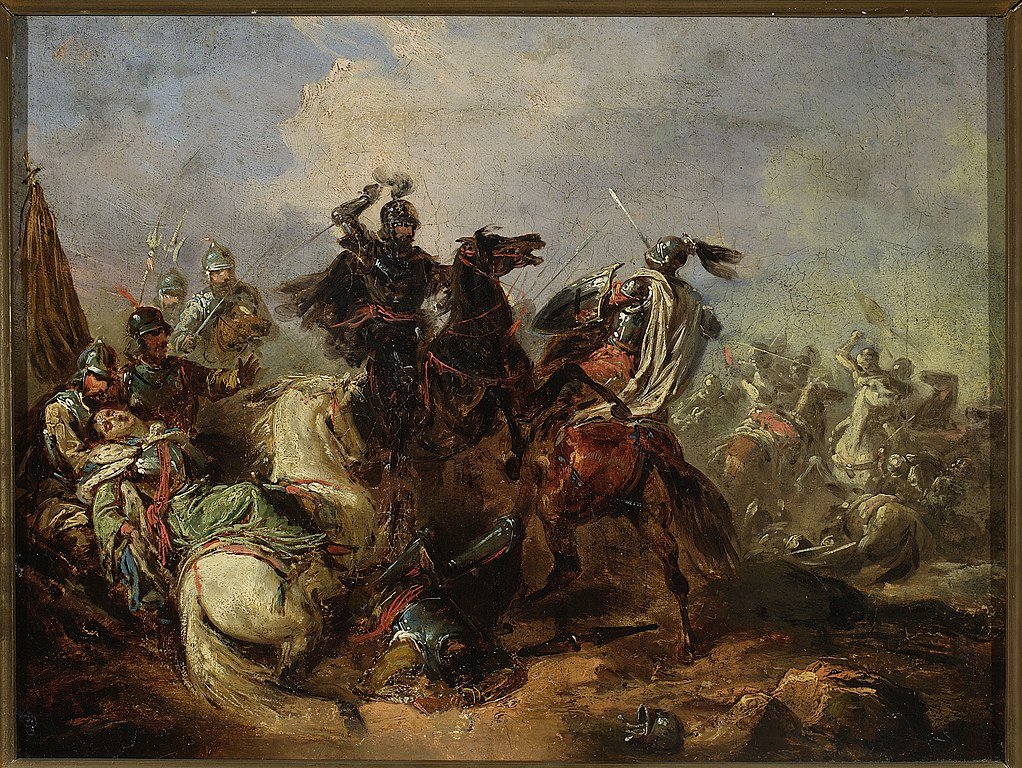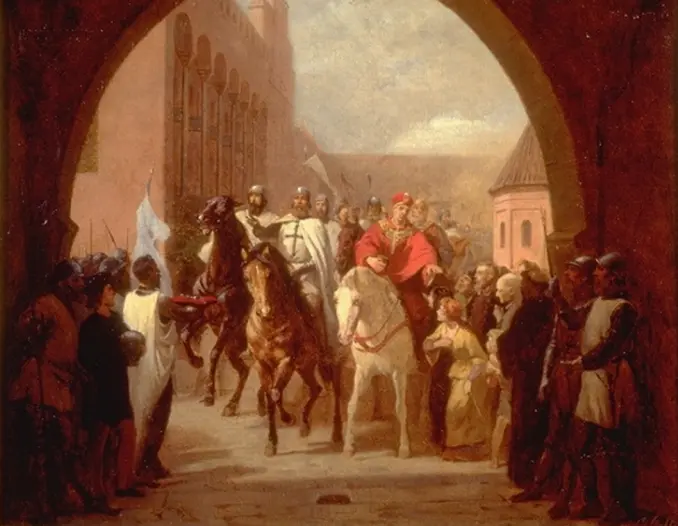Medieval Germany flourished with a vibrant knightly culture and numerous knightly orders, thriving within the spirited martial ethos of the German nobility. One of the eminent orders was the Teutonic Order, which wielded considerable influence politically, militarily, and culturally across medieval Europe. Renowned German knights emerged from this Order, known for their gallant pursuits.

Historically, the Teutonic Order played a pivotal role as a crusading military force, compelling conversion to Catholicism in the Holy Land and the Baltics during the Middle Ages. Additionally, the Order extended its shield to safeguard Catholics in Eastern Europe. This legacy is interwoven with the tapestry of medieval Europe.
In this article, we will take a look at six of the most famous German Knights of all time.
Heinrich Walpot von Bassenheim
Heinrich Walpot von Bassenheim, also known as Henry Walpot, emerged from a prosperous lineage hailing from Mainz and harbored a vision to transform the organization into a formidable military order. He assumed the role of the inaugural Grand Master of the Teutonic Knights, leading from 1198 until around 1208. Given the scarcity of concrete details, much of the knowledge concerning this Grand Master rests on historical conjecture.
The demise of Hohenstaufen Emperor Heinrich VI in 1197 significantly reshaped the Teutonic Order. Guided by Heinrich Walpot von Bassenheim, they metamorphosed into an autonomous military order in 1198, securing privileges from Popes Celestine III and Innocent III.
In 1199, Walpot acquired a set of monastery rules from Gilbert Horal, the Grand Master of the Knights Templar, endorsed by Pope Innocent III. This framework was rooted in the Templars’ regulations. Tragically, Walpot’s life was cut short in 1200 CE in Acre.
Franz Von Sickingen
Franz von Sickingen, a prominent German knight, led the renowned “Knights’ Revolt” and emerged as a key figure during the early Reformation. He displayed a talent for championing the oppressed side in conflicts, using this as a pretext to amass troops against oppressors, often gaining bribes or expanding his influence into different territories.

Sickingen’s adept strategies greatly influenced the election of the Holy Roman Emperor, Charles V, who appointed him as a counselor.
Noteworthy was Sickingen’s role as a patron and protector of scholars. His castles provided refuge for persecuted intellectuals of his time, including Martin Luther.
However, on October 22, 1522, a regency council placed him under banishment. In response, he seized Kaiserslautern in the spring of 1523. Facing opposition from the Archbishop of Trier, Palatine Elector Louis V, and the Landgrave of Hesse, Sickingen resisted during the siege at Nanstein Castle, where he suffered a fatal injury.
This event marked the early use of artillery, breaching the seemingly impregnable fortress. Sickingen surrendered on May 6, 1523, and passed away the following day.
Tannhauser
Tannhäuser, a 13th-century German knight and poet, is closely linked to the Teutonic Order in historical records. Notably, historical references suggest his likely participation alongside the Order’s knights during the Fifth Crusade.
Tannhauser’s claim to fame was his poetry which inspired many subsequent German artists in the later centuries. A sizable body of legends also grew around his name during the late medieval period. In the post-medieval period, Richard Wagner famously produced the Tannhauser opera in which the legend of the knight was given a theatric treatment.
The legendary tale of Tannhäuser, inspired by his Bußlied, portrays him as a knight-poet who discovers the Venusberg, Venus’s underground abode and devotes a year to worshipping her. Overcome with guilt, he journeys to Rome to seek forgiveness from Pope Urban IV, who equates his absolution to his staff blooming, an impossible feat. Just three days later, Urban’s staff blossoms, prompting a search for Tannhäuser, who had already escaped by then.
Georg von Frundsberg
Georg von Frundsberg was a distinguished German knight and leader of the Landsknechte, who played a pivotal role in the military history of the Holy Roman Empire and the Habsburg House.
Born in 1473 to a lineage of military prowess, Frundsberg’s initial exposure to warfare came in 1492, as he supported his father against Duke Albert IV of Bavaria. His affiliation with the Habsburgs led him to adopt innovative strategies, notably utilizing pike square infantry to counter traditional armored knights.
Frundsberg’s leadership fostered the formidable Landsknecht regiment, known for its prowess and disciplined approach. His dedication to training and leadership made him an enduring influence on military strategists of future generations.
Georg von Frundsberg maintained an active military career, engaging in battles across Italy, defending cities, and earning his famous motto “Viel Feind, viel Ehr” (many foes, much honor). Frundsberg’s strategic brilliance was pivotal in key moments, including the Battle of Bicocca, and the iconic victory at Pavia, where the French king was captured.
Heinrich Von Bulow
Heinrich Von Bulow was a German knight who rose to significant fame during the 14th century. He belonged to the German nobility and was notably known for his archetypal role as the robber baron.
Von Bülow gained prominence in 1383 by attacking Wilsnack due to a feud with the Bishop of Havelberg. This inadvertently sparked an economic resurgence after the discovery of undamaged portions of The Host(Christ’s Blood) in the fire’s aftermath, drawing pilgrims for 170 years. In 1385, Prince Albrecht III and the Hanseatic League launched an offensive against von Bülow, destroying his strongholds, including Castle Preensberg.
In 1389, Heinrich Von Bulow became a significant warlord for the King Akbert of Sweden, holding Plau am See. Notably, he held a large debt, reflecting his influence in Mecklenburg’s power structure, and resided in Neustadt-Glewe Castle.
Gotz Von Berlichingen
Götz von Berlichingen, a medieval German knight, carved a formidable military path, offering his mercenary expertise to a diverse array of monarchs and barons. He also left a literary legacy, having authored an autobiography and demonstrated his poetic prowess.
During his youth, Berlichingen’s loss of his right arm prompted him to craft an iron prosthetic hand capable of grasping a sword. His military exploits were predominantly concentrated in the first half of the 16th century when he pledged his service to prominent figures like Frederick I, Holy Roman Emperor Maximilian I, and Albert IV of Bavaria.
Entangled in the significant events of his era, Berlichingen found himself caught up in the turbulence of the German Peasants’ Revolt. Remarkably, he managed to disentangle himself from legal accusations and later aligned with Charles V, the Holy Roman Emperor.
Also Read: 5 Famous Spanish Knights Who Became Figures Of Legend
